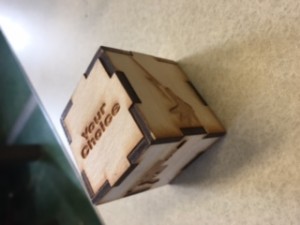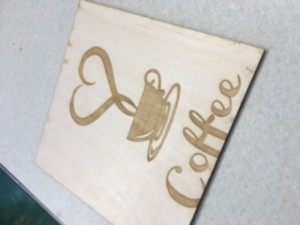In week 2 of 3 in the FabLab I worked in the laser engraving and laser cutting station. So much design was available in this part of the FabLab, where users can utilize more than one station to achieve their masterpieces. Duncan showed us many examples of work using the laser engraver, like this cube, for example.

The laser engraver has two modes: rastering and cutting. Rastering is what is on all six faces of the cube: not cutting all the way through the material, but just etching a design. The minimum size of line the machine can raster is 0.1 cm. Cutting is exactly what the word means: cutting all the way through the material. To achieve the cube required both modes, but putting the cube together required use of the woodshop section of the FabLab. The laser cutter would cut the shape of the cube and then the cube could be hammered together to fit nicely. Since a laser is isolated high intensity light, it basically burns whatever material it is directed at. This limits the amount of materials that a laser cutter can be used on, within a safe level. The materials offered at the FabLab included wood, acrylic and glass. Unsafe examples would include PVC (poly vinyl chloride) pipes, which not only would melt under a laser cutter, but also releases chloride gas when cut.
I wanted to raster an image onto a piece of wood. I chose my image from the Internet and saved it onto a program called Inkscape, an open-source software with vector based graphics. Converting an image to a vector graphic allows the laser cutter to pick up a solid image and not be muddled with many pixels. This was my end product.

My takeaway from this week was focused more on the technology offered to allow a user to achieve his/her design. The laser cutters have many options to allow the user to design with a larger variety of materials. Another aspect I noticed from this week and also with the embroidery station is that these machines worked like printers. Both the laser cutter and the digital embroidery machine started from the top and worked its way to the bottom in straight lines. This is why the hardware is so precise because it will not miss a spot. My experience in the FabLab is becoming more and more interesting by each session, so I can’t wait to see what’s in store next time we visit!


Oh I didn’t know that we are also doing the laser engraving and laser cutting. Look forward to it!